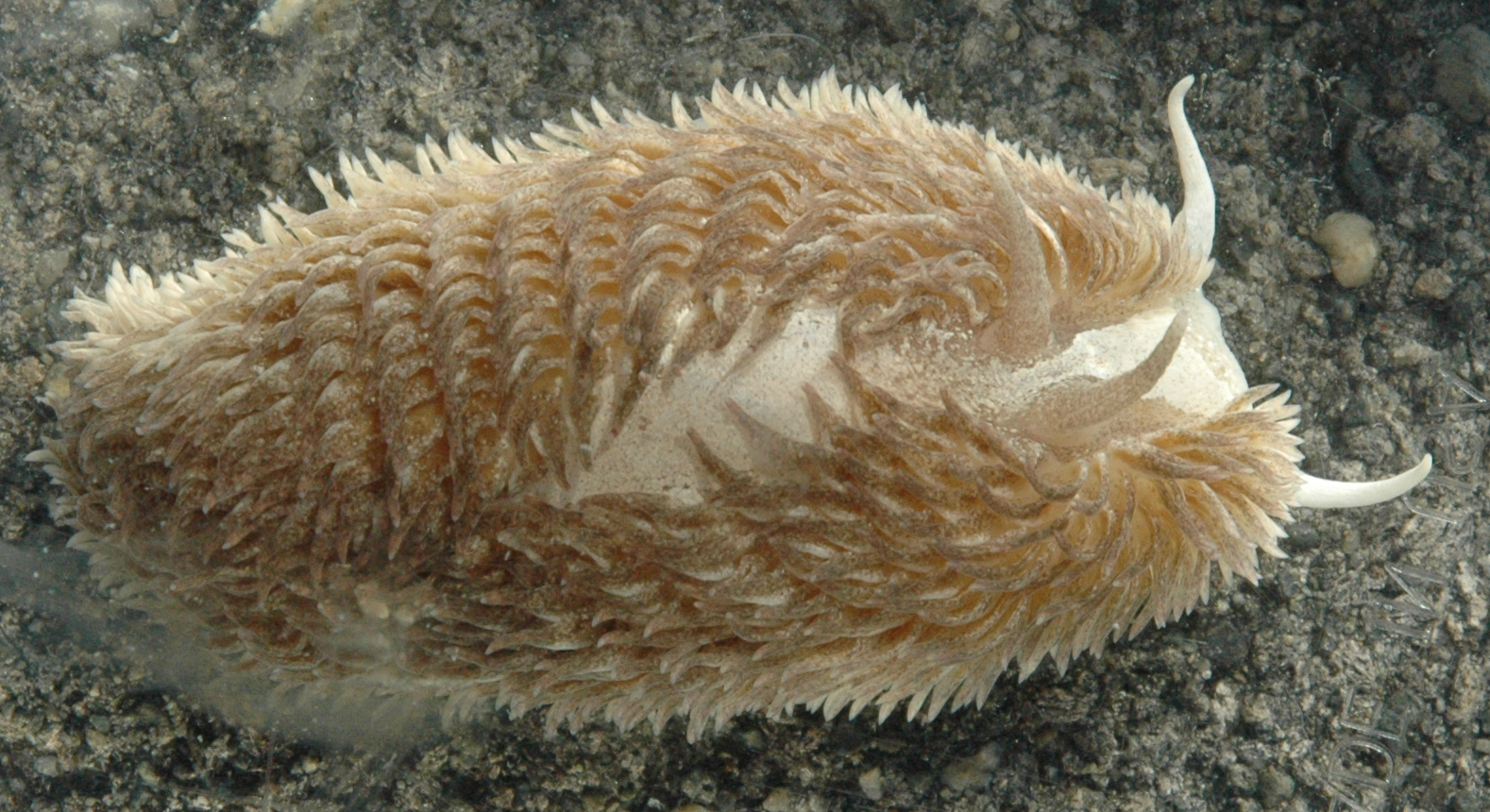Aeolidia loui (Linnaeus, 1761)Common name(s): Shag-rug aeolis, shag rug nudibranch, mossy nudibranch, shaggy mouse nudibranch, common grey sea slug, maned nudibranch, papillose aeolid, sea mouse |
|
| Synonyms: Aeolidea papillosa, Aeolidia farinacea, Limax papillosa |  |
|
Class Gastropoda
Suborder Aeolidacea
|
|
| Aeolidia loui, approximately 4.5 cm long, found on a rock in Padilla Bay. This individual is crawling around the side of a dish. The rhinophores are visible in front with light tips, while one white pedal tentacle is visible on the extreme right. | |
| (Photo by: Dave Cowles, July 2008) | |
How to Distinguish from Similar Species: Specimens in our area were formally recognized as A. papillosa but are now classified as a new species, Aeolidia loui. (Kienberger et al., 2016). Aeolidia papillosa has smooth rhinophores and cerata which remain approximately the same width from base to near the top, while A. loui (the species found here) has "warty" rhinophores and cerata which are wider and thinner at the base than at the tips. Flabellina salmonacea looks similar but no cerata are attached anterior to the rhinophores. A deep-water species, A. herculea, lives at depths greater than 500 m.
Geographical Range: Northern or northeast Pacific?
Depth Range: Intertidal to 900 m
Habitat: On rocks, or may be on floats or docks. Often near its perferred prey, Anthopleura elegantissima.
Biology/Natural History: Feeds on anemones, especially Anthopleura elegantissima and secondarily Metridium senile. Also may feed on Urticina crassicornis, Anthopleura xanthogrammica, and Epiactis prolifera, the young of which it may swallow whole, as well as sea pens and hydroids. It can detect its prey from a distance. It apparently does not prey on Anthopleura artemisia. It is said to be a voracious predator, consuming enough anemone tissue to equal half or all its body weight per day. It preys on large anemones by first spreading mucus on the column, then biting off and swallowing chunks. The mucus may shield the nudibranch from nematocyst discharge, plus this species' mucus seems to elicit less nematocyst discharge than does the mucus from other, non-anemone-eating nudibranchs such as Hermissenda crassicornis or Cadlina luteomarginata so it may have some inhibitory effect. (Anemones may eat Hermissenda or Cadlina, but Aeolidia eats the anemone). Tough cuticle in the mouth and esophagus may protect those areas from nematocysts. It may eventually eat entire large anemones. After eating Anthopleura elegantissima which is symbiotic with algae, the algae may also be segregated into the tips of its cerata where they continue photosynthesis. This species is famous for obtaining undischarged cnidae (cells which bear nematocysts) from its Cnidarian prey and moving them through the hepatic diverticula to the tips of the cerata, where they are likely used for defense. If disturbed they sometimes wave their cerata. If one of the cerata is broken off, muscles within it contract, expelling the nematocysts, which then discharge.
In SE Alaska this species reproduces late March to late April. It lays a white to pinkish, coiled string of eggs in capsules which are attached to rocks or eelgrass leaves. In Washington, eggs hatch as veligers after 10-24 days.
The nudibranch Phidiana hiltoni may attack this nudibranch (Goddard et al., 2011)
| Return to: | |||
| Main Page | Alphabetic Index | Systematic Index | Glossary |
References:
Dichotomous Keys:Flora and Fairbanks, 1966 (as Aeolidia papillosa)
Kozloff 1987, 1996 (as Aeolidia papillosa)
McDonald and Nybakken, 1980 (as Aeolidia papillosa)
General References:
Behrens,
1991
Carefoot,
1977
Kozloff,
1993
Lamb
and Hanby, 2005
Niesen,
1994, 1997
O'Clair
and O'Clair, 1998
Ricketts
et al., 1985
Scientific Articles:
Goddard, Jeffrey H., Terrence M. Gosliner, and John S. Pearce, 2011. Impacts associated with the recent range shift of the aeolid nudibranch Phidiana hiltoni (Mollusca: Opisthobranchia) in California. Marine Biology DOI: 10.1007/s00227-011-1633-7
Harris, Larry G. and Nathan R. Howe, 1979. An
analysis of the defensive mechanisms observed in the anemone Anthopleura elegantissima
in response to its nudibranch predator Aeolidia papillosa.
Biological Bulletin 157: pp. 138-152
Kienberger, Karen, Leila Carmona, marta Pola, Vinicius Padula, Terrence M. Gosliner, and Juan Lucas Cervera, 2016. Aeolidia papillosa
(Linnaeus, 1761) (Mollusca: Heterobranchia: Nudibranchia), single
species or cryptic species complex? A morphological and moleculara
study. Zoological Journal of the Linnean Society 177: pp481-506.
doi: 10.1111/zoj.12379
Waters, V. L.,
1973. Food-preference of
the nudibranch Aeolidia
papillosa,
and the effect of the defenses of the prey on predation.
Veliger
15: 174-192
Web sites:
General Notes and
Observations: Locations,
abundances, unusual behaviors:
I have rarely seen this species here near Rosario. The individual above was one of two on a large rock in a muddy intertidal area of March Point, Padilla Bay, along with Metridium senile anemones and chitons.
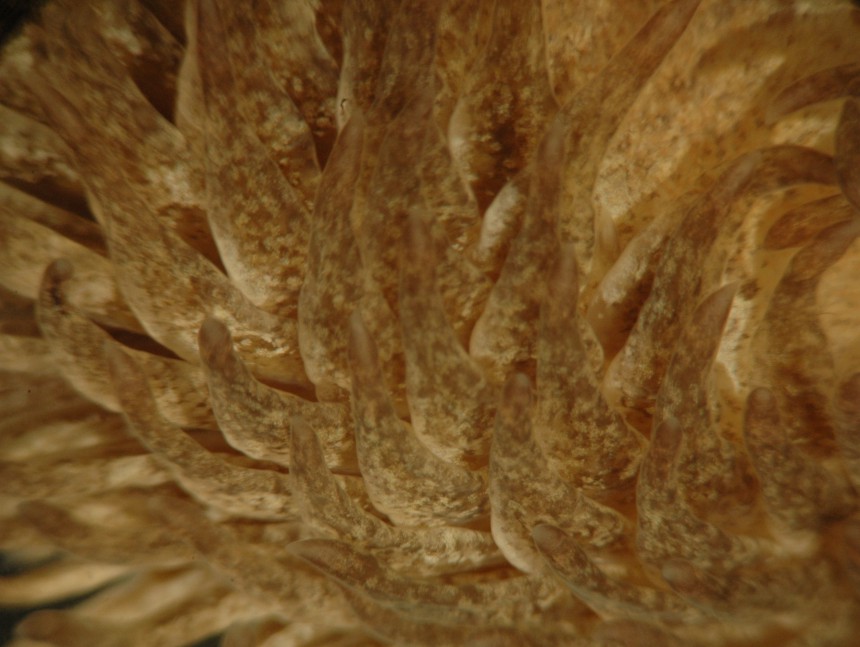
The cerata
are flattened, widest above the base, and taper to a point.
The hepatic
diverticula cannot be readily seen within them if there is pigment
present.
The tips often take on the coloration of their anemone food.
The
mid-dorsal band, which is cerata-free
but has light cororation on it, can be seen to the right.
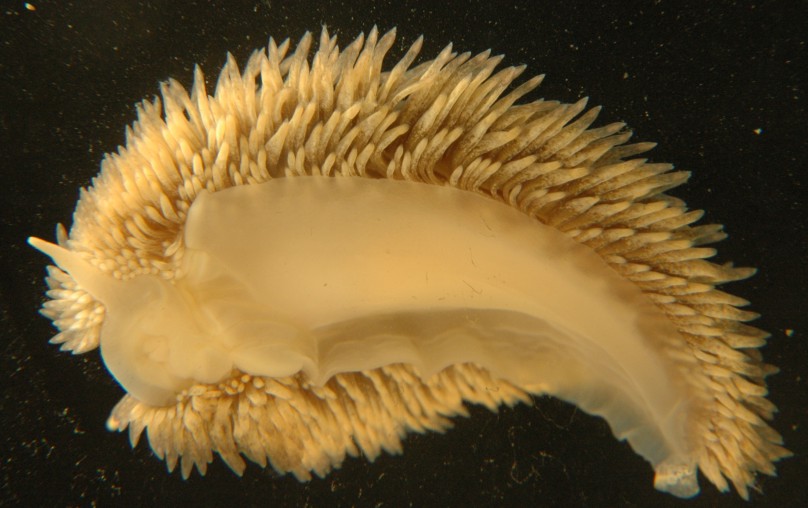
The foot tapers but is not drawn out into a long, sharp point.
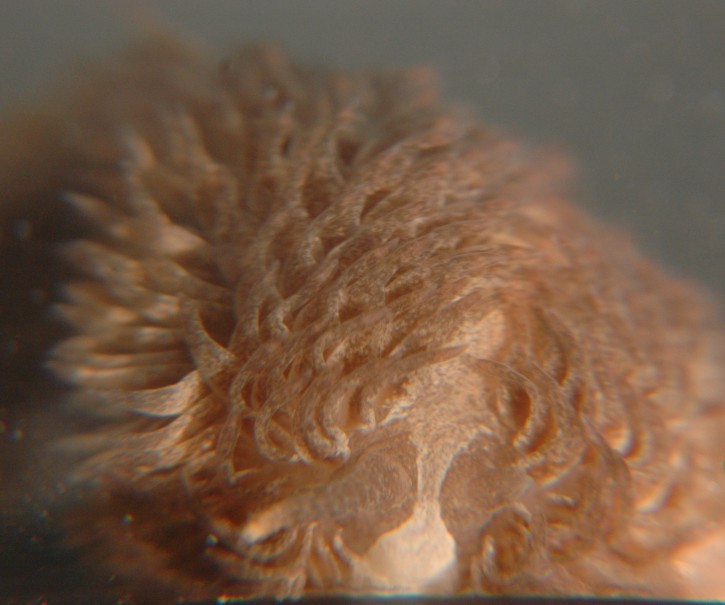
This head-on view shows the white triangle anterior to the rhinophores.
It also shows the smooth, tapering rhinophore
with a light-colored tip, and the fact that the rhinophore
seems to have a pore in the end. Notice also the cerata-free
band that runs mid-dorsally and has light coloration.
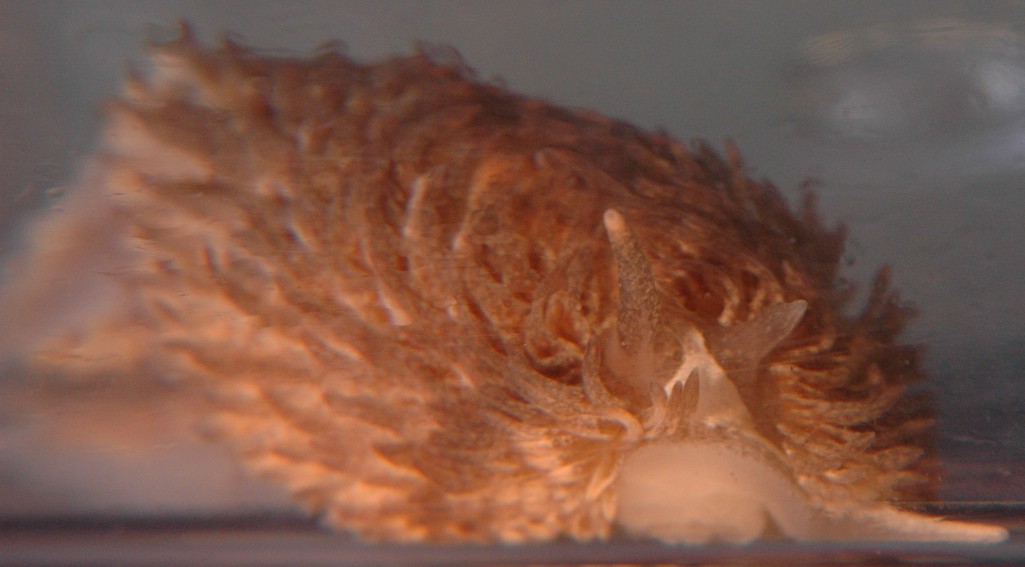
This head-on view shows the rhinophores
(the one on the right seems to have been injured and truncated), plus
one
of the two pedal
tentacles extends to the right.
| In the sequence below, Aeolidia papillosa encounters and briefly attacks a Metridium giganteum anemone, eliciting the discharge of acontia from the anemone. | |
 |
 |
| The nudibranch's first encounter with the anemone | The nudibranch crawls out onto the column of the anemone. I did not see any copious quantities of mucus secreted, but that may be because I placed these two together. Earlier I had placed the nudibranch on the column of the anemone but it rolled up into a ball and dropped off. |
 |
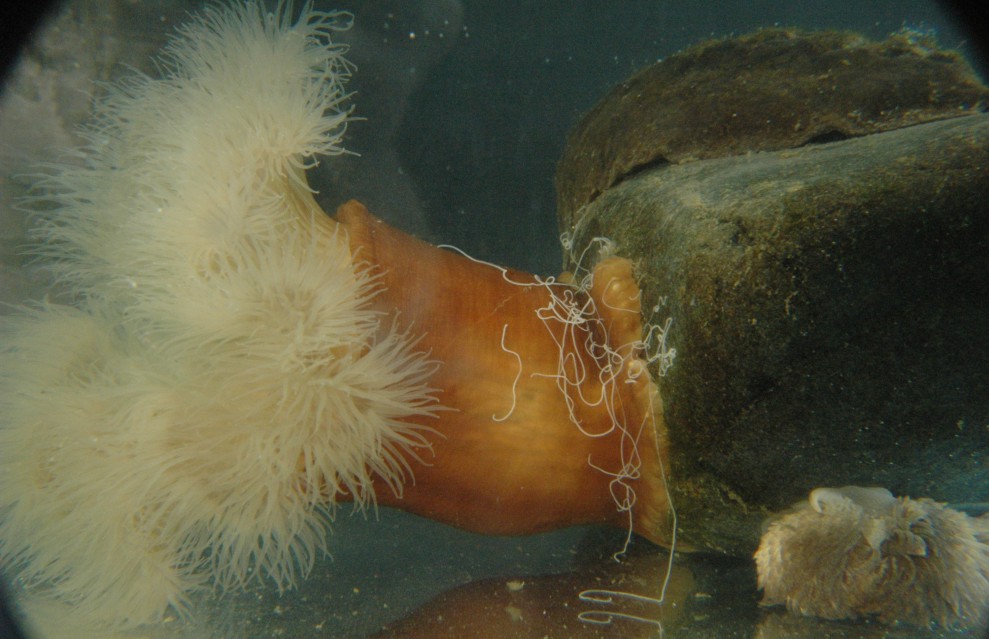 |
| Shortly after the nudibranch crawled out onto the anemone, the anemone rapidly contracted and closed up. The nudibranch turned away. | After the nudibranch left the anemone began opening up, then discharged multiple acontia from the column wall. |
Authors and Editors of Page:
Dave Cowles (2008): Created original page
CSS coding for page developed by Jonathan Cowles (2007)
